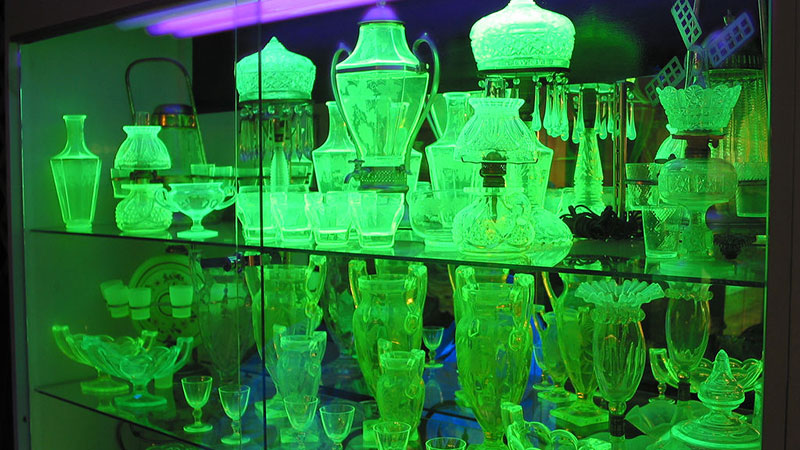Ever wondered what makes certain pieces of glass glow a vivid green under ultraviolet light? You might be surprised to learn that the answer lies in a quirky and fascinating material known as uranium glass. This captivating substance has a rich history and a mesmerizing allure that has captured the hearts of collectors and scientists alike. Let’s dive into the glowing world of uranium glass, exploring its origins, unique properties, and modern-day appeal.
What is Uranium Glass?
Uranium glass, sometimes referred to as Vaseline glass, is a type of glass that contains small amounts of uranium oxide. This inclusion gives the glass a distinctive green or yellow tint and, more intriguingly, makes it fluoresce under ultraviolet (UV) light. The use of uranium in glass dates back to the early 19th century, and its striking appearance has made it a popular choice for decorative items and tableware.
The History of Uranium Glass
Early Beginnings
The story of uranium glass begins in the early 1800s. The first recorded use of uranium in glassmaking occurred around 1830, attributed to Josef Riedel in Bohemia (modern-day Czech Republic). At this time, glassmakers were experimenting with various additives to create new and exciting colors. Uranium oxide was found to impart a beautiful greenish hue to the glass, making it an instant hit among the European elite.
Victorian Popularity
Uranium glass reached the height of its popularity during the Victorian era. The striking fluorescence under UV light was an intriguing novelty, and many households displayed uranium glass items as a mark of sophistication. The glass was used to make a variety of objects, from vases and bowls to intricate figurines and jewelry. The vibrant, glowing pieces were often used as conversation starters at dinner parties and social gatherings.
Decline and Rediscovery
The production of uranium glass saw a decline during the early 20th century, largely due to the discovery of the harmful effects of radioactivity. However, the actual health risks posed by uranium glass are minimal, as the uranium content is typically very low and the glass itself does not emit significant radiation. Despite this, public concern led to a decrease in production. It wasn’t until the mid-20th century that uranium glass saw a resurgence, fueled by collectors and antique enthusiasts who appreciated its unique beauty and historical significance.
The Science Behind the Glow
Composition and Fluorescence
The key to uranium glass’s distinctive glow lies in its chemical composition. The addition of uranium oxide (usually in concentrations of 2% or less) to the glass mixture creates the signature green or yellow tint. When exposed to UV light, the uranium atoms become excited and emit visible light, resulting in the characteristic fluorescence. This phenomenon occurs because the uranium atoms absorb the high-energy UV light and then release lower-energy visible light as they return to their ground state.
Safety Concerns
One common question about uranium glass is whether it is safe to handle and use. While uranium is radioactive, the levels present in uranium glass are quite low. The radiation emitted by uranium glass is minimal and not considered harmful with normal handling. However, as a precaution, it is advisable to avoid prolonged exposure to large quantities of uranium glass or to use it for food and drink storage.
Collecting Uranium Glass
Identifying Authentic Pieces
For those interested in collecting uranium glass, identifying authentic pieces is an important skill. Genuine uranium glass will always exhibit fluorescence under UV light. Collectors often use a portable UV flashlight to verify the authenticity of a piece. Additionally, uranium glass tends to have a distinctive color and texture that sets it apart from other types of glass.
Popular Collectibles
Uranium glass comes in many forms, from simple bowls and vases to more elaborate pieces like chandeliers and decorative figurines. Some of the most sought-after items include Depression glass, which was mass-produced in the United States during the 1930s and 1940s. These pieces are prized for their historical value as well as their unique appearance. Other popular collectibles include Victorian-era items and Art Deco pieces, which often feature intricate designs and high-quality craftsmanship.
Caring for Uranium Glass
Caring for uranium glass is relatively straightforward. To maintain its beauty, it is best to display the pieces in a location where they are protected from dust and potential damage. Cleaning should be done gently, using mild soap and water. Avoid harsh chemicals and abrasive materials, as these can damage the glass’s surface. When handling uranium glass, especially valuable or delicate items, it’s important to do so with care to prevent chips and cracks.
Modern-Day Uses and Popularity
Contemporary Artists and Designers
In recent years, uranium glass has experienced a revival, with contemporary artists and designers incorporating it into their work. The unique properties of the glass make it an attractive medium for creating visually striking pieces. Some modern artists use uranium glass to create jewelry, sculptures, and other decorative items, bringing a touch of historical charm to contemporary design.
Scientific and Educational Value
Beyond its aesthetic appeal, uranium glass also holds scientific and educational value. Museums and educational institutions often use uranium glass to teach about the properties of radioactivity and fluorescence. Its ability to visually demonstrate these concepts makes it a valuable tool for science educators. Additionally, the historical context of uranium glass provides insight into the evolution of materials science and industrial innovation.
Conclusion: The Timeless Allure of Uranium Glass
The story of uranium glass is a fascinating journey through history, science, and art. From its early days in the workshops of Bohemia to its status as a cherished collectible, uranium glass has captivated generations with its unique glow and vibrant colors. Whether you’re a seasoned collector, a curious newcomer, or simply someone who appreciates beautiful and unusual objects, the world of uranium glass offers something for everyone. So next time you see a piece of glass glowing under UV light, you’ll know there’s a rich and radiant history behind that captivating green glow.
faqsChatGPT
FAQs About Uranium Glass
1. What is uranium glass?
Uranium glass is a type of glass that contains small amounts of uranium oxide, which gives it a green or yellow tint and causes it to fluoresce under ultraviolet (UV) light.
2. Why does uranium glass glow under UV light?
The glow occurs because the uranium atoms in the glass absorb UV light and then emit visible light as they return to their ground state. This process is known as fluorescence.
3. Is uranium glass safe to handle?
Yes, uranium glass is generally safe to handle. The uranium content is very low, and the radiation emitted is minimal. However, it is advisable to avoid prolonged exposure to large quantities or using it for food and drink storage.
4. How can I identify authentic uranium glass?
Authentic uranium glass will fluoresce under UV light. Using a portable UV flashlight is a reliable method to check for this characteristic glow. Additionally, it often has a distinctive green or yellow color and a particular texture.
5. When was uranium glass first made?
Uranium glass was first produced around 1830 by Josef Riedel in Bohemia (modern-day Czech Republic).
6. Why did the production of uranium glass decline in the early 20th century?
The production declined due to public concerns about the harmful effects of radioactivity, despite the minimal health risks associated with the low uranium content in the glass.
7. What types of items are made from uranium glass?
Uranium glass has been used to make a variety of items, including vases, bowls, figurines, jewelry, chandeliers, and Depression glass tableware.
8. How should I care for uranium glass?
To maintain uranium glass, display it in a protected area to avoid dust and damage. Clean it gently with mild soap and water, avoiding harsh chemicals and abrasive materials.
9. Is uranium glass still being produced today?
Yes, uranium glass is still produced, though on a smaller scale. It is mainly used by artists and designers for creating unique decorative items and jewelry.
10. Can uranium glass be used for educational purposes?
Absolutely. Uranium glass is often used in museums and educational settings to demonstrate the properties of radioactivity and fluorescence, providing a hands-on way to learn about these scientific concepts.
11. What are some popular collectibles in uranium glass?
Popular collectibles include Depression glass from the 1930s and 1940s, Victorian-era pieces, and Art Deco designs. These items are valued for their historical significance and unique beauty.
12. How did uranium glass get its name “Vaseline glass”?
The term “Vaseline glass” comes from the glass’s appearance, which is similar to the color and texture of petroleum jelly, also known as Vaseline.
13. Are there any risks associated with collecting uranium glass?
The primary risk is minimal radiation exposure, which is not significant enough to cause harm with normal handling. Collectors should, however, handle their pieces carefully to avoid damage.
14. What makes uranium glass so appealing to collectors and enthusiasts?
Its unique glow under UV light, historical significance, and the craftsmanship involved in creating intricate designs make uranium glass highly appealing to collectors and enthusiasts.
15. Where can I find uranium glass for my collection?
Uranium glass can be found at antique shops, online marketplaces, estate sales, and auctions. Some specialized dealers and collectors’ groups also trade in uranium glass items.
If you have more questions or want to learn even more about the captivating world of uranium glass, there are numerous resources and collector communities ready to share their knowledge and passion.



